#poc history
Text
European history is not white


Someone commented this to a post I reblogged, which message is basically "we shouldn't venerate the Dead White Man HistoryTM and we should elevate other history too, but we still need to learn Dead White Man HistoryTM to understand the world today". It's basically a response to the attitude you sometimes come across in the internet that sees learning about those Dead White MenTM as not worth our time. And this person, who seems to be following this blog because they responded to my reblog, takes it as a personal attack against all white Europeans. For some reason. Well I take these comments as a personal attack against historical understanding.
Firstly, the post clearly didn't say you shouldn't venerate any European history, because not all European history is Dead White Man HistoryTM. Obviously this person thinks European history is white, which is not true, but surely, surely, they know it's not all men? Secondly, what is "west culture"? When did it start? There is not one western culture, not one European culture. The first concept of some shared Europeanness was the Christendom in Middle Ages, but it was not exactly the same as we think of Europe today, because it did not include the pagan areas, but it included a lot of Levant and parts of Central Asia, where there were large Christian areas. And Europe was not "very white" nor was the Christendom. The more modern concept of West was cooked in tandem with race and whiteness during colonial era and Enlightenment, around 17th to 18th centuries. And Europe was certainly not very white then. The western world also includes a lot of colonized areas, so that's obviously not white history. Thirdly, implying that asking white people to apologize for European history (which no one did ask) is as ridiculous as asking black people for African history is... a choice. Black people do exist in a lot of other places than Africa, which white people should be the ones apologizing for, and really white people also have a lot to answer for about African history. Lastly, if you think the quote "anyone who thinks those dead white guys are aspirational is a white supremacist" means you as an European are demanded to apologize for your existence, maybe - as we say in Finland - that dog yelps, which the stick clanks. (I'm sorry I think I'm the funniest person in the world when I poorly translate Finnish sayings into English.)
The thing is, there is no point in European history, when Europe was white, for three reasons. 1) Whiteness was invented in 17th century and is an arbitrary concept that has changed it's meaning through time. 2) Whichever standard you use, historical or current, Europe still has never been all or overwhelmingly white, because whiteness is defined as the in-group of colonialists, and there has always been the internal Other too. In fact the racial hierarchy requires an internal Other. 3) People have always moved around a lot. The Eurasian steppe and the Mediterranean Sea have always been very important routes of migration and trade. I've been meaning to make a post proving exactly that to people like this, since as I've gathered my collection of primary images of clothing, I've also gathered quite a lot of European primary images showing non-white people, so I will use this opportunity to write that post.
So let's start from the beginning. Were the original inhabitants of Europe white? Of course not. The original humans had dark skin so obviously first Europeans had dark skin. Whenever new DNA evidence of dark skinned early Europeans come out (like this study), the inevitable right-wing backlash that follows is so interesting to me. Like what did you think? Do you still believe the racist 17th century theories that white people and people of colour are literally different species? I'm sure these people will implode when they learn that studies (e.g. this) suggest in fact only 10 000 years ago Europeans had dark skin, and even just 5 000 years ago, when Egypt (an many others) was already doing it's civilization thing, Europeans had brown skin (another source). According to the widely accepted theory, around that time 5 000 years ago the Proto-Indo-European language developed in the Pontic-Caspian steppe, which extends from Eastern Europe to Central Asia. These Proto-Indo-Europeans first migrated to Anatolia and then to Europe and Asia. Were they white? Well, they were probably not light skinned (probably had brown skin like the other people living in Europe around that time), the Asian branch of Indo-European peoples (Persians, most Afghans, Bengalis, most Indians, etc.) are certainly not considered white today and a lot of the people today living in that area are Turkic and Mongolic people, who are also not considered white. I think this highlights how nonsensical the concept of race is, but I don't think Proto-Indo-Europeans would have been considered white with any standard.
Around Bronze Age light skin became common among the people in Europe, while in East Asia it had become wide spread earlier. This does not however mark the point when "Europe became white". During the Bronze Age there was a lot of migration back and forth in the Eurasian steppe, and the early civilizations around Mediterranean did a lot of trade between Europe, Africa and Asia, which always means also people settling in different places to establish trading posts and intermarrying. There were several imperial powers that also stretched to multiple continents, like the briefly lived Macedonian Empire that stretched from Greece to Himalayas and Phoenicians from Levant, who didn't built an empire but settled in North Africa, Sicily and Iberia. In Iron Age the Carthaginian Empire, descendants of Phoenician settlers in current Tunisia, build an Empire that spanned most of the western Mediterranean coast. Their army occupying that area included among others Italic people, Gauls, Britons, Greeks and Amazigh people.
Iron Age also of course saw the rise of the Roman Republic, and later empire, but it was preceded by Etruscans, who populated Tuscan, and possibly preceded the Indo-European presence. However, weather through trade and migration with other Mediterraneans or the continuing presence of darker skin tones of the early Europeans, their art quite often depicts darker skin tones too, like seen below in first two images. Roman Empire at it's height spanned from Babylonia to the British Isles. They recruited soldiers from all provinces and intentionally used stationed them in different areas so they wouldn't be too sympathetic to possible rebels or neighboring enemies. Historical sources mention black Nubian soldiers in British Isles for example. They also built a lot of infrastructure around the empire to ensure protection and easy transportation through trade routes inside the empire. During this time Jewish groups also migrated from Levant to both North-Africa and Europe. Rome even had non-European emperors, like Septimius Severus who originated from Levant and was Punic (descendants of Phoenicians) from his father's side, and who was depicted with darker skin (third picture below). Various ethnicities with differing skin tones are represented all over Roman art, like in the fourth picture below from hunting lodge in Sicily.

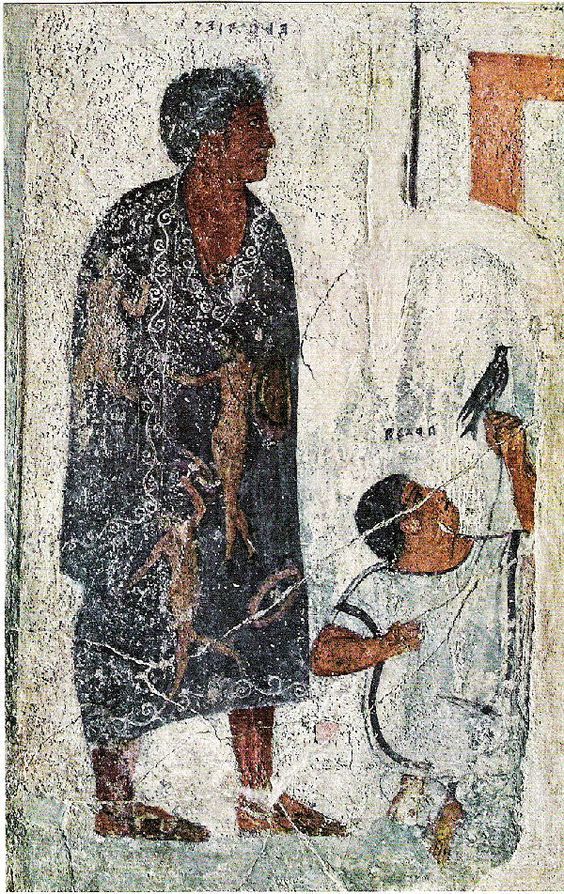


Eurasian steppe continued to be important source of migration and trade between Europe and Asia. Scythians, Iranic nomadic people, were important for facilitating the trade between East Asia and Europe through the silk road during the Iron Age. They controlled large parts of Eastern Europe ruling over Slavic people and later assimilating to the various Slavic groups after loosing their political standing. Other Iranic steppe nomads, connected to Scythian culture also populated the Eurasian steppe during and after Scythia. During the Migration Period, which happened around and after the time of Western Rome, even more different groups migrated to Europe through the steppe. Huns arrived from east to the Volga region by mid-4th century, and they likely came from the eastern parts of the steppe from Mongolian area. Their origins are unclear and they were either Mongolic, Turkic or Iranic origin, possibly some mix of them. Primary descriptions of them suggests facial features common in East Asia. They were possibly the nomadic steppe people known as Xiongnu in China, which was significant in East and Central Asia from 3rd century BCE to 2nd century CE until they moved towards west. Between 4th and 6th centuries they dominated Eastern and Central Europe and raided Roman Empire contributing to the fall of Western Rome.
After disintegration of the Hun Empire, the Huns assimilated likely to the Turkic arrivals of the second wave of the Migration Period. Turkic people originate likely in southern Siberia and in later Migration period they controlled much of the Eurasian steppe and migrated to Eastern Europe too. A Turkic Avar Khagenate (nation led by a khan) controlled much of Eastern Europe from 6th to 8th century until they were assimilated to the conquering Franks and Bulgars (another Turkic people). The Bulgars established the Bulgarian Empire, which lasted from 7th to 11th in the Balkans. The Bulgars eventually adopted the language and culture of the local Southern Slavic people. The second wave of Migration Period also saw the Moor conquest of Iberia and Sicily. Moors were not a single ethnic group but Arab and various Amazigh Muslims. Their presence in the Iberian peninsula lasted from 8th to 15th century and they controlled Sicily from 9th to 11th century until the Norman conquest. During the Norman rule though, the various religious and ethnic groups (which also included Greeks and Italic people) continued to live in relative harmony and the North-African Muslim presence continued till 13th century. Let's be clear that the Northern Europe was also not white. Vikings also got their hands into the second wave migration action and traveled widely to east and west. Viking crews were not exclusively Scandinavians, but recruited along their travels various other people, as DNA evidence proves. They also traded with Byzantium (when they weren't raiding it) and Turkic people, intermarried and bought slaves, some of which were not white or European. A Muslim traveler even wrote one of the most important accounts of Vikings when encountering them in Volga.
By this point it should already be clear that Medieval Europe was neither white, but there's more. Romani people, who originate from India and speak Indo-Aryan language, arrived around 12th century to Balkans. They continued to migrate through Europe, by 14th century they were in Italy, by 15th century in Germany and by 16h century in Britain and Sweden. Another wave of Romani migration from Persia through North-Africa, arrived in Europe around 15th century. Then there's the Mongol Empire. In 13th century they ruled very briefly a massive portion of the whole Eurasian continent, including the Eastern Europe. After reaching it's largest extent, it quickly disintegrated. The Eurasian Steppe became the Golden Horde, but lost most of the Eastern-Europe, except Pontic-Caspian Steppe. They ruled over Slavs, Circissians, Turkic groups and Finno-Ugric groups till early 15th century. The Mongolian rulers assimilated to the Turkic people, who had been the previous rulers in most of the steppe. These Turkic people of the Golden Horde came to be known as Tatars. Golden Horde eventually split into several Tatar khagenates in 15th century, when the khagenates, except the Crimean Khagenate, were conquered by the Tsardom of Moscovy. Crimean Khagenate was annexed by the Russian Empire in 1783. Crusades were a movement from Europe to Levant, but they also meant intermarriage in the the Crusader kingdoms especially between the European and Levant Christians, and some movement back and froth between these kingdoms and Europe, trade and a lot of movement back after the Crusader kingdoms were defeated in 13th century. Generally too trade across the Mediterranean sea was extensive and led to migration and intermarriage.
And here's some example of people of colour in Medieval European art, shown as part of the majority white European societies. First is from a 15th century French manuscript depicting Burgundy court with dark skin courtier and lady in waiting. Second one is from a Flemish manuscript from 15th century of courtiers, including a black courtier, going for a hunt. Third is a 15th century Venetian gondolier with dark skin.

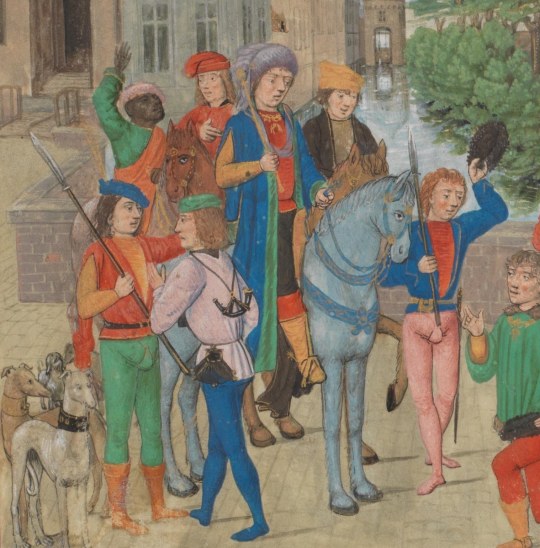

In Renaissance Era Europe was only increasing it's trade and therefore had even more connections outside Europe. The first picture below is Lisbon, which had strong trade relationship with Africa, depicted in late 16th century. People with darker skin tones were part all classes. Second image is an Italian portrait of probably a seamstress from 16th century. Third one is a portrait of one of the personal guards of the Holy Roman Emperor. Fourth image is a portrait of Alessandro de' Medici, duke of Florence, who was noted for his brown complexion, and the modern scholarly theory is that his mother was a (likely brown) Italian peasant woman.
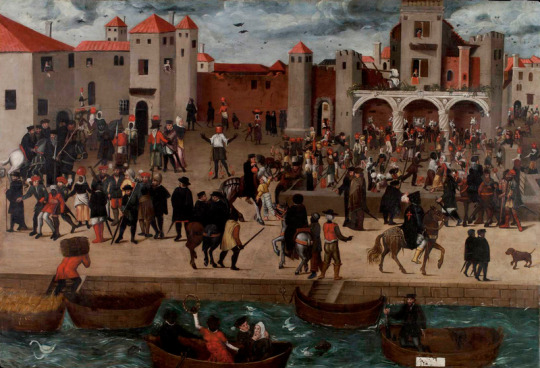

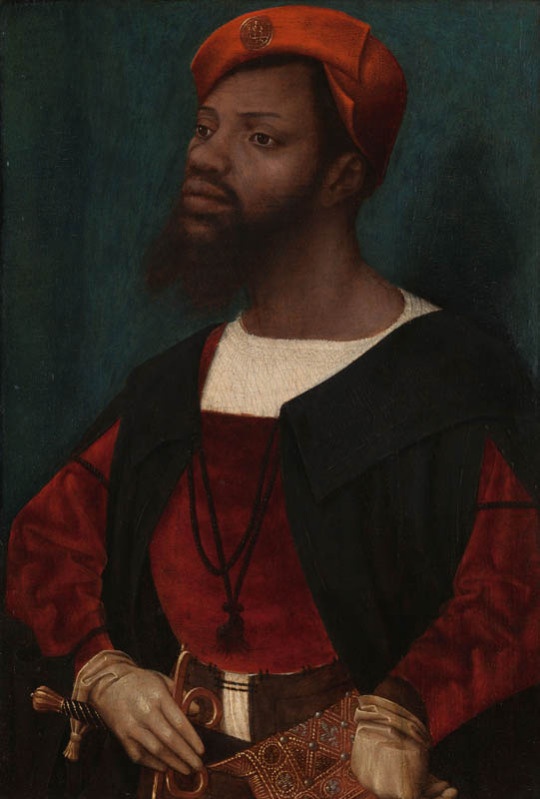

Colonialism begun in the Renaissance Era, but the wide spread colonial extraction and slavery really got going in the 17th century. Racial hierarchy was developed initially to justify the trans-Atlantic slave trade specifically. That's why the early racial essentialism was mostly focused on establishing differences between white Europeans and black Africans. Whiteness was the default, many theories believed humans were originally white and non-whites "degenerated" either through their lives (some believed dark skin was basically a tan or a desease and that everyone was born white) or through history. Originally white people included West-Asians, some Central-Asians, some North-Africans and even sometimes Indigenous Americans in addition to Europeans. The category of white inevitably shrank as more justifications for atrocities of the ever expanding colonial exploitation were required. The colonial exploitation facilitated development of capitalism and the industrial revolution, which led to extreme class inequality and worsening poverty in the European colonial powers. This eventually became an issue for the beneficiaries of colonialism as worker movements and socialism were suddenly very appealing to the working class.
So what did the ruling classes do? Shrink whiteness and give white working classes and middle classes justifications to oppress others. Jews and Roma people had long been common scapegoats and targets of oppression. Their oppression was updated to the modern era and racial categories were built for that purpose. The colonial powers had practiced in their own neighborhoods before starting their colonial projects in earnest and many of those European proto-colonies were developed to the modern colonial model and justified the same way. In 19th century, when racial pseudoscience was reaching it's peak, Slavs, others in Balkan, the Irish (more broadly Celts), Sámi (who had lost their white card very early), Finns, Southern Italians, the Spanish, the Southern French and Greeks all were considered at least not fully white. The Southern Europeans and many Slavs were not even colonized (at least in the modern sense, though with some cases like Greeks it's more complicated than that), but they looked too much and were culturally too similar to other non-white Mediterraneans, and they were generally quite poor. In many of these cases, like Italians, the French and Slavs, it was primarily others belonging in the same group, who were making them into second class citizens. All this is to highlight how very malleable the concept of race is and that it's not at all easy to define the race of historical people.
However, even if we would go with the racial categories of today, Europe was still far from being all white in this period. You had Roma, who certainly are not included in whiteness today, and European Jews, whose whiteness is very conditional, descendants of Moors in Southern Europe and Tatars and Turks in Eastern Europe and Turkey, which today is often not thought of as part of Europe, but historically certainly was. And then colonialism brought even more people into Europe forcibly, in search of work because their home was destroyed or for diplomatic and business reasons. There were then even more people of colour, but they were more segregated from the white society. Black slaves and servants are very much represented in European art from 17th century onward, but these were not the only roles non-white people in Europe were in, which I will use these examples to show. First is a Flemish portrait of Congo's Emissary, Dom Miguel de Castro, 1643. Second is a 1650 portrait of a Moorish Spanish man Juan de Pareja, who was enslaved by the artist as artisanal assistant, but was freed and became a successful artist himself. Third is a 1768 portrait of Ignatius Sancho, a British-African writer and abolitionist, who had escaped slavery as a 20-year-old. Fourth painting is from 1778 of Dido Elizabeth Belle, a British gentlewoman born to a slave mother who was recognized as a legitimate daughter by her father, and her cousin. The fifth portrait is of an unknown woman by (probably) a Swiss painter from late 18th century. Sixth is a 1760s Italian portrait of a young black man.

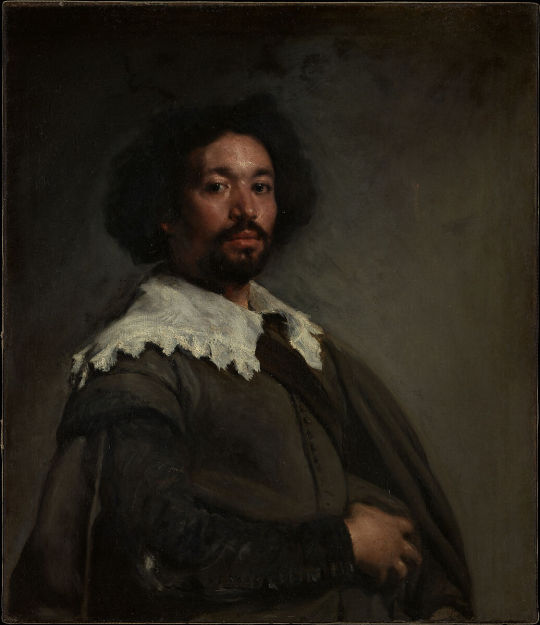
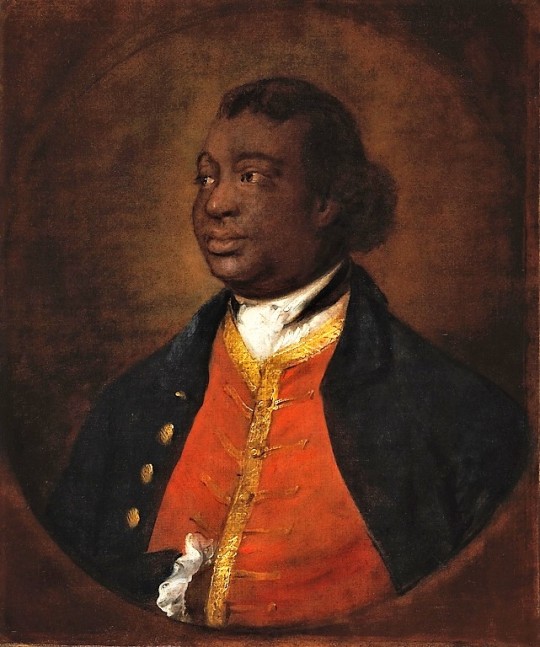
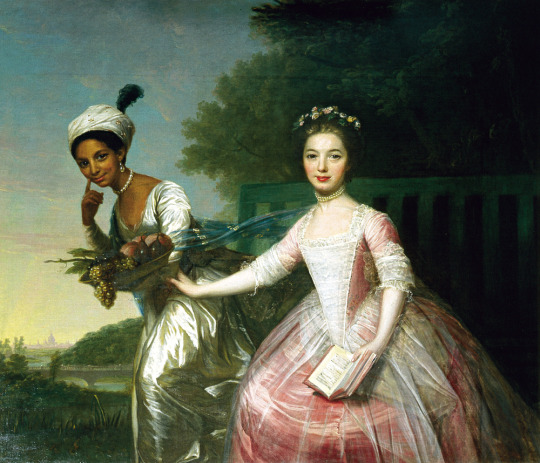
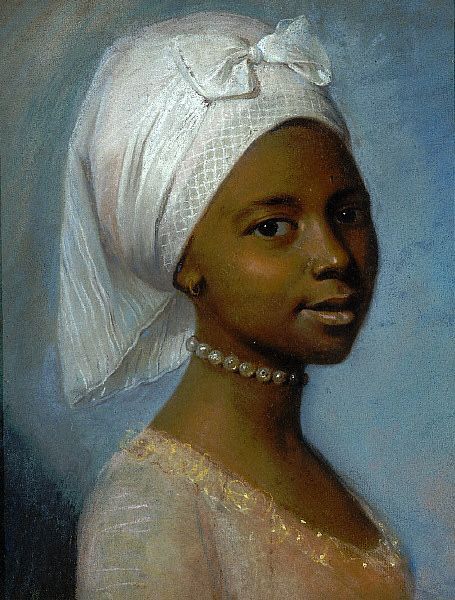
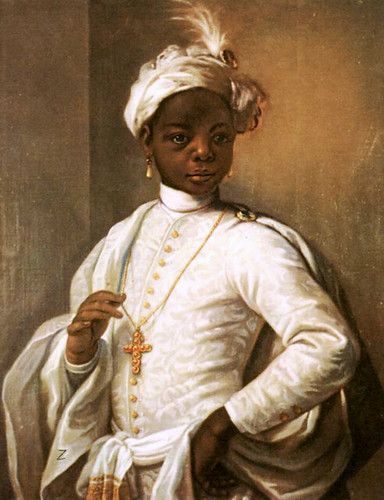
In late 18th century England abolished slavery in British Isles first, then in early 19th century in the whole British Empire, thanks to the continuous campaign of free Black people and some white allies, notably Quakers. Around the same time slavery was abolished in France (briefly till Napoleon got to power) after the French revolution. This meant there were a lot more free black people in Europe after that. In 18th century the Europeans, British especially, were colonizing Asia as much they could, which meant that in 19th century there started to also be a lot more Asian, especially Indian people in Europe. First picture below is of Thomas Alexander Dumas, who was son of a black slave woman and a white noble French man and became a general in the French revolutionary army. His son was one of the most well-known French authors, Alexander Dumas, who wrote The Count of Monte Cristo and The Three Musketeers. Second portrait is of Jean-Baptiste Belley, a Senegalese former slave, who became French revolutionary politician. Third portrait is from 1810 of Dean Mahomed, an Indian-British entrepreneur, who established the first Indian restaurant in London. Forth is Arab-Javanese Romantic painter Saleh Syarif Bustaman, who spend years in Europe. Fifth is a 1862 photo of Sara Forbes Bonnetta, originally named Aina, princess of Edbago clan of Yoruba, who was captured into slavery as a child, but later freed and made Queen Victoria's ward and goddaughter. She married a Nigerian businessman, naval officer and statesman, James Pinson Labulo Davies (sixth picture).
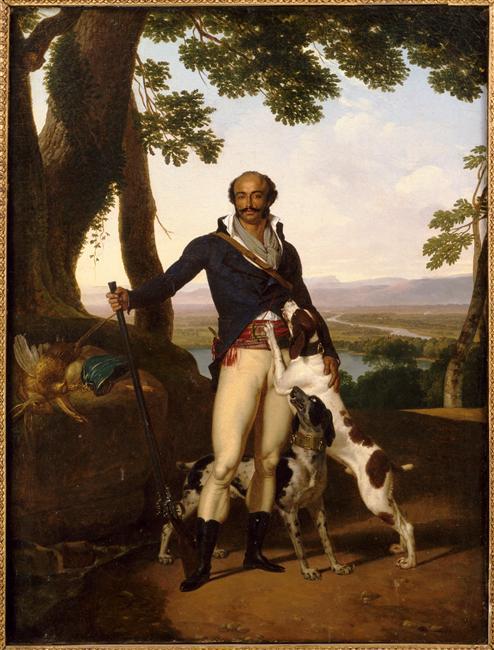


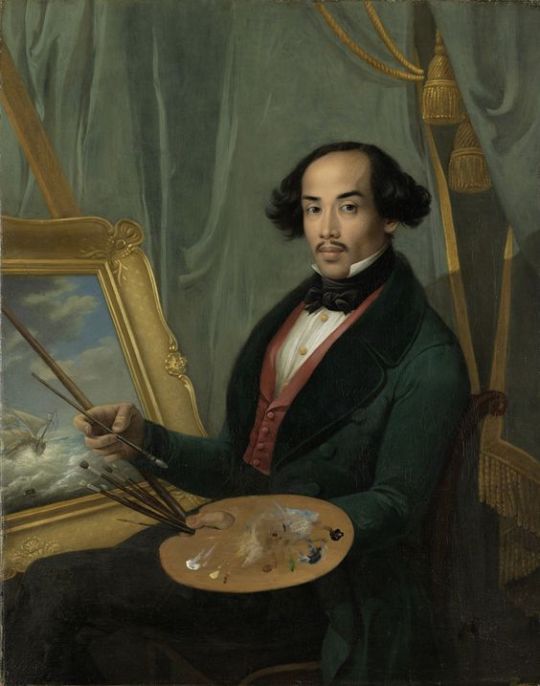
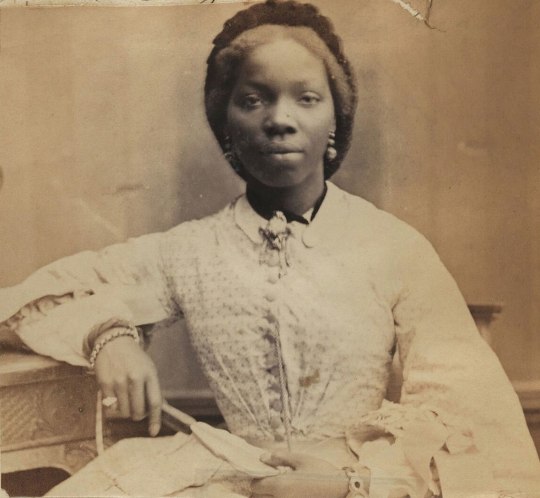
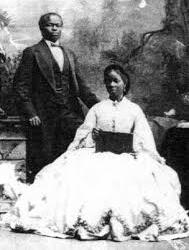
So any guesses on at what point was that "very white Europe" when the "west culture" begun? It kinda seems to me that it never actually existed.
#history#poc history#black history#historical art#european history#history of race#colonialism#racism#slavery#painting#photograph
174 notes
·
View notes
Text
I've changed my mind, there should be a white male history month. And lessons about white male history would ONLY be taught during that month. If they couldn't understand why they didn't need the month, this is the way I'd show them.
#history#equality#tired of the patriarchy#tired of white people not getting it#thoughts#shouting into the void#fuck the patriarchy#im here for it#black history month#black history matters#womens history#womens history month#poc history#world history#eurocentrism#sucks
13 notes
·
View notes
Text
Katie Findlay shared this awesome video on her IG stories about the history of POC cowboys in the early years! And since I love history, I started watching some of Tanaissa's other videos and found this one about queer history and cowboys!
It's all really fascinating if you want to take a look. From what we've heard so far, it sounds like this is the kind of representation that Walker: Independence is working towards.
38 notes
·
View notes
Text
Recently found some people are confused as to why they added the black and brown stripe to the queer flag, since being poc isn’t inherently queer. So here’s why!
Yknow all the rights we have? Yeah black trans women did like all of those
#we are in debt#and we need to be more grateful about it#queer#lgbtq#lgbt#lgbt pride#lgbtqia#lgbt history#queer history#trans women are amazing#trans women#trans#trans mtf#transgender#poc women#poc#poc representation#poc history#history#black trans#black women#black womanhood#black woman appreciation#black woman power#blacklivesmatter#Blm#stonewall#black trans women#poc trans#progress flag
13 notes
·
View notes
Text
Reminder 2 that if your alt subculture excludes any minority (especially PoC and/or poor people) it’s not a real alt subculture and you are gross!
Alt subcultures were started by poor black people in the 50s-60s and 95% of other subcultures from there were started by other poor PoC. You can’t discriminate against the people who started something in the first place.
You are a poser if you are classist and/or racist!
13 notes
·
View notes
Text







Here are more pictures of the movement and a newspaper article! Thank you so much for the love and please research this movement and keep the history alive !!
If you’d like to know a quick summary you can look at my page :))
Stay safe everyone have a good one :))
#black panthers#polynesian#polynesian history#poc history#history#learn about this#read about this#justice#justice for our people#bipoc#black panther#pacific islander#dark history#nojusticenopeace#Polynesian panthers#dont let this flop#pic history#forgotten history
22 notes
·
View notes
Text
I’m eating lunch right now and there’s a news report about how the current senator of Florida wants to block a potential high school class about black history.
When they mentioned that they’re trying to show a complete history, the good and bad, it reminded me of something I heard about Japan.
Idk if this is still a thing (or if it ever was a thing, but I’m 99% sure it’s real), but in Japanese schools, the students wouldn’t be taught about Japan’s role in WWII and the horrible things they did, such as an event referred to as ‘The Rape of Nanking’ (idk if I spelled that right, sorry).
The difference, however, is that Japan felt immense shame over these events, and don’t talk about it because of their honor (I think? Pls be nice to me, I learned about this ~5 years ago.). American Republicans, however, don’t seem to feel shame over the horrible past treatment of black people/ other poc.
Is Japan in the right for hiding this part of history? No. Do I understand why they do it? Yes. It’s a different culture with different ideals and values, and, like I said, there is shame.
The US isn’t able to use an excuse like that. There is no American culture/ideal that everyone follows, because of all the different people from different places with different cultures that populate it.
I have so many feelings about this, but I don’t know enough about these topics to give a full, accurate explanation of it, not to mention how horrible I am at fully explaining my feelings. Anyone more knowledgeable in these topics, please help???
#sorry if I got anything wrong#feel free to correct me#black history#teaching#teachers#education#poc history#history#random rant#my mind is a mess all the time all the time#I can’t fully explain anything because my thoughts are fragmented and I don’t quite know how to put everything together#so I really hope I made some semblance of sense
2 notes
·
View notes
Text
“you don’t owe people anything” actually i owe all the dead people in history who were treated badly to be remembered and loved and you do to!!
3 notes
·
View notes
Text
i just rbed a post about something similar but. i need my white disabled to folks to be more aware of the privileges they have when navigating the healthcare system. every bit of medical ableism one can experience can be made even worse by being a poc. some of us can't threaten to report a doctor to the ethics board, or refuse care from healthcare workers who aren't masking, without jeopardizing our access to care in general or even our physical safety. we are more likely to be seen as drug seeking, or marked as noncompliant, or experience medical abuse and neglect. that's not to say these things don't happen to white disabled people, but i just think it's important to recognize how dangerous receiving medical care can be for disabled poc specifically. please keep this in mind when giving advice on navigating healthcare.
#mj.txt#disabled#disabled poc#black history month#cripple punk#medical ableism#medical racism#medical abuse#lots of tags sorry
5K notes
·
View notes
Text

Lady, you are literally admitting to a war crime on tv.
#israel#politics#news#palestine#free palestine#muslims#south africa#democrats#republicans#woc#books#history#hebrew#wtf#human rights#poc
5K notes
·
View notes
Text
The Ultimate Dark Academia Book Recommendation Guide Ever
The title of this post is clickbait. I, unfortunately, have not read every book ever. Not all of these books are particularly “dark” either. However, these are my recommendations for your dark academia fix. The quality of each of these books varies. I have limited this list to books that are directly linked to the world of academia and/or which have a vaguely academic setting.
Dark Academia staples:
The Secret History by Donna Tartt
If We Were Villains by M.L. Rio
Dead Poets Society by Nancy H. Kleinbaum
Vita Nostra by Maryna Dyachenko
Dark academia litfic or contemporary:
Bunny by Mona Awad
The Idiot by Elif Batuman
These Violent Delights by Micah Nemerever
White Ivy by Susie Yang
The Cloisters by Katy Hays
Never Let Me Go by Kazuo Ishiguro
The Lake of Dead Languages by Carol Goodman
A Separate Peace by John Knowles
Black Chalk by Christopher J. Yates
Attribution by Linda Moore
Dark academia thrillers or horror:
In My Dreams I Hold a Knife by Ashley Winstead
The Maidens by Alex Michaelides
Ghosts of Harvard by Francesca Serritella
Catherine House by Elisabeth Thomas
Plain Bad Heroines by Emily M. Danforth
They Never Learn by Layne Fargo
The It Girl by Ruth Ware
Never Saw Me Coming by Vera Kurian
Dark academia fantasy/sci-fi:
Babel: An Arcane History by R.F. Kuang
The Atlas Six by Olivie Blake
Ninth House by Leigh Bardugo
A Lesson in Vengeance by Victoria Lee
The Starless Sea by Erin Morgenstern
Vicious by V.E. Schwab
A Discovery of Witches by Deborah Harkness
The Betrayals by Bridget Collins
Dark academia romance:
Gothikana by RuNyx
Alone With You in the Ether by Olivie Blake
Dark academia YA or MG:
Truly Devious by Maureen Johnson
A Deadly Education by Naomi Novik
Ace of Spades by Faridah Àbíké-Íyímídé
The Raven Boys by Maggie Stiefvater
Legendborn by Tracy Deonn
Crave by Tracy Wolff
Wilder Girls by Rory Power
The Harry Potter series by J.K. Rowling
Dark academia miscellaneous:
My Dark Vanessa by Kate Elizabeth Russell
Disorientation by Elaine Hsieh Chou
Alphabet of Thorn by Patricia A. McKillip
#dark academia#dark academia books#dark academia aesthetic#poc dark academia#light academia#chaotic academia#books and literature#book blog#ya books#books#book recs#book recommendations#the secret history#if we were villains#babel an arcane history#the atlas six#ninth house#legendborn#dead poets society#bookblr#bookstagram#academia#academic#bookish#vicious ve schwab#the maidens#the raven boys#vita nostra
10K notes
·
View notes
Text
I Hate How She Talks About Snow White

"People are making these jokes about ours being the PC Snow White, where it's like, yeah, it is − because it needed that. It's an 85-year-old cartoon, and our version is a refreshing story about a young woman who has a function beyond 'Someday My Prince Will Come. "
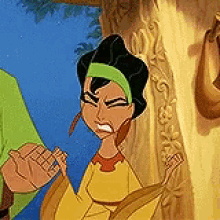
Let me tell you a little something's about that "85-year-old cartoon," miss Zegler.
It was the first-ever cel-animated feature-length full-color film. Ever. Ever. EVER. I'm worried that you're not hearing me. This movie was Disney inventing the modern animated film. Spirited Away, Into the Spider-Verse, Tangled, you don't get to have any of these without Snow White and the Seven Dwarfs (1937.)
Speaking of what you wouldn't get without this movie, it includes anime as a genre. Not just in technique (because again, nobody animated more than shorts before this movie) but in style and story. Anime, as it is now, wouldn't exist without Osamu Tezuka, "The God of Manga," who wouldn't have pioneered anime storytelling in the 1940s without having watched and learned from Snow White and the Seven Dwarfs in the 1930s. No "weeb" culture, no Princess Mononoke, no DragonBall Z, no My Hero Academia, no Demonslayer, and no Naruto without this "85-year-old cartoon."
It was praised, not just for its technical marvels, not just for its synchronized craft of sound and action, but primarily and enduringly because people felt like the characters were real. They felt more like they were watching something true to life than they did watching silent, live-action films with real actors and actresses. They couldn't believe that an animated character could make kids wet their pants as she flees, frightened, through the forest, or grown adults cry with grieving Dwarves. Consistently.
Walt Disney Studios was built on this movie. No no; you're not understanding me. Literally, the studio in Burbank, out of which has come legends of this craft of animated filmmaking, was literally built on the incredible, odds-defying, record-breaking profits of just Snow White and the Seven Dwarfs, specifically.
Speaking of record-breaking profits, this movie is the highest-grossing animated film in history. Still. TO THIS DAY. And it was made during the Great Depression.
In fact, it made four times as much money than any other film, in any other genre, released during that time period. It was actually THE highest-grossing film of all time, in any genre, until nothing less than Gone With the Wind, herself, came along to take the throne.
It was the first-ever animated movie to be selected for the National Film Registry. Actually, it was one of the first movies, period, to ever go into the registry at all. You know what else is in the NFR? The original West Side Story, the remake of which is responsible for Rachel Ziegler's widespread fame.
Walt Disney sacrificed for this movie to be invented. Literally, he took out a mortgage on his house and screened the movie to banks for loans to finish paying for it, because everyone from the media to his own wife and brother told him he was crazy to make this movie. And you want to tell me it's just an 85-year-old cartoon that needs the most meaningless of updates, with your tender 8 years in the business?
Speaking of sacrifice, this movie employed over 750 people, and they worked immeasurable hours of overtime, and invented--literally invented--so many new techniques that are still used in filmmaking today, that Walt Disney, in a move that NO OTHER STUDIO IN HOLLYWOOD was doing in the 30's, put this in the opening credits: "My sincere appreciation to the members of my staff whose loyalty and creative endeavor made possible this production." Not the end credits, like movies love to do today as a virtue-signal. The opening credits.
It's legacy endures. Your little "85-year-old cartoon" sold more than 1 million DVD copies upon re-release. Just on its first day. The Beatles quoted Snow White in one of their songs. Legacy directors call it "the greatest film ever made." Everything from Rolling Stones to the American Film Institute call this move one of the most influential masterpieces of our culture.
This movie doesn't need anything from anybody. This movie is a cultural juggernaut for America. It's a staple in the art of filmmaking--and art, in general. It is the foundation of the Walt Disney Company, of modern children's media in the West, and of modern adaptations of classical fairy tales in the West.
When you think only in the base, low, mean terms of "race" and "progressivism" you start taking things that are actually worlds-away from being in your league to judge, and you relegate them to silly ignorant phrases like "85-year-old cartoon" to explain why what you're doing is somehow better.
Sit down and be humble. Who the heck are you?
#Snow White#Snow White and the seven dwarfs#snow#snow white 1937#snow white and the seven dwarfs 1937#Snow White 2024#Rachel zegler#west side story#poc#Disney#live action Disney hate#animation history#Do not go see this movie. Do not stream this movie.#Anime#anime history
5K notes
·
View notes
Text
It wouldn’t be historically accurate for my story to include BIPOC!
This is an argument often made about European-style fantasy media like Game of Thrones, Lord of the Rings, and Disney’s Frozen. Audiences, often white, assume that due to the majority-white setting, adding any visible number of BIPOC to the story would be unrealistic.
What these critics fail to realize is that BIPOC do in fact live, and have lived, in these settings, and records of BIPOC presence in places assumed to be majority-white have been buried, written out, or not taught due to white supremacist and/or colonial bias in the field of history. There are historical European settings that were far more diverse than is often portrayed. Consider:
The Moorish Empire exerted an extensive influence over life and culture in Southern Europe from Spain from 711 to 1492
The Ottomans were heavily involved in European affairs up until the treaty of Karlowitz in 1699, but still considered a part of Europe even through the 19th century
The sheer size of the Roman Empire ensured the continued movement of people from various backgrounds within the Mediterranean well until the end of the Byzantine Empire.
“Historical accuracy” should not be used as an excuse for media to be exclusively white in its casting. While there are places which are or were predominantly white, there will always be factors like global trade and immigration that bring multiculturalism to their doors.
And even if the presence of a certain demographic is unrealistic for a certain setting? Consider that we’ve accepted far worse inaccuracies in historical fiction in the name of artistic license. Consider that our understanding of human history is, and will always be, incomplete.
Further Reading:
Historically Diverse London, “Historical Accuracy,” and Creator Accountability
Making a Black Pride and Prejudice Resonate
---
This Q&A is an excerpt from our General FAQ for Newcomers, which can be found in our new Masterpost of rules and FAQs. If you're new to Writing With Color and/or want more writing resources, check it out!
-Writing With Color
#writing with color#writeblr#representation#poc representation#history#historical fiction#historical accuracy#writing advice#writing tips#writers on tumblr#diverse books#diversity matters#faq
3K notes
·
View notes
Text


Lucy Diggs Slowe (deceased)
Gender: Female
Sexuality: Lesbian
DOB: 4 July 1885
RIP: 21 October 1937
Ethnicity: African American
Occupation: Former prof tennis player, professor, activist
Note of firsts: First Black woman to serve as Dean of Women at any American university. Won the national title of the American Tennis Association's first tournament in 1917, the first African-American woman to win a major sports title. First person from her school to attend Howard University.
#Lucy Diggs Slowe#lgbt history#black history#lgbt#lesbian#female#1885#rip#historical#black#poc#african american#athlete#tennis#teacher#activist#first#popular#popular post#300
432 notes
·
View notes
Text
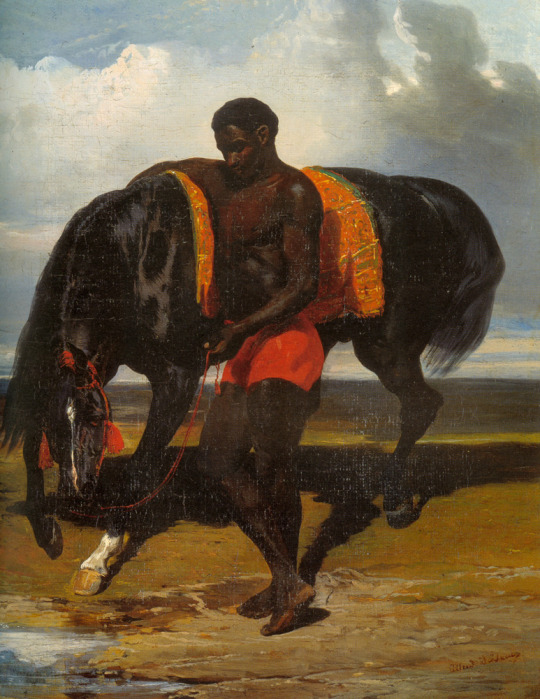
African Holding a Horse at the Edge of a Sea, Alfred de Dreux (1810-1860)
#art#art history#Alfred de Dreux#genre painting#genre art#poc in art#animalier#animals in art#horse#horses#Orientalism#Orientalist art#French art#19th century art#oil on canvas#private collection
1K notes
·
View notes
Text

Happy black history month ya'll!!!
#black history month#black lives still matter#black lives are important#black lives fucking matter#black lives have always mattered#black lives matter#black liberation#black community#poc artist#blm#my art 2024#black power#blm is not a terrorism group#black is beautiful#black is divine#artists on tumblr#black artists#artists of color#black artists on tumblr#fluffytimearts#my artwork#my art#yes yes I know another artstyle change fuck off--#signal boost#chibi art#chibi style#black history month 2024
521 notes
·
View notes